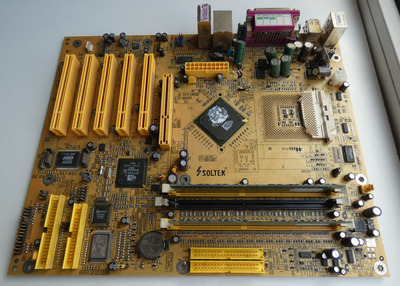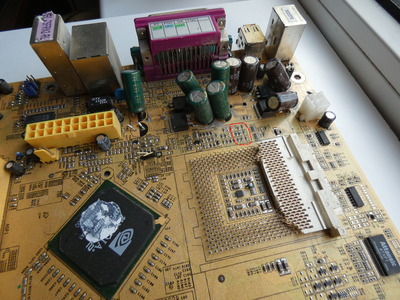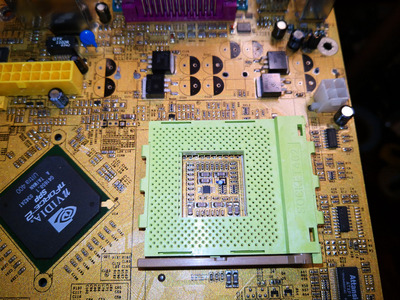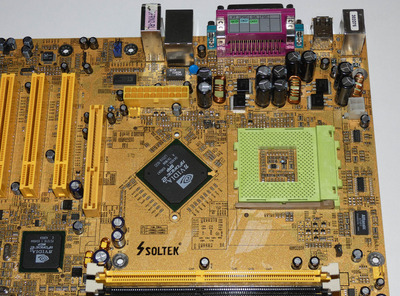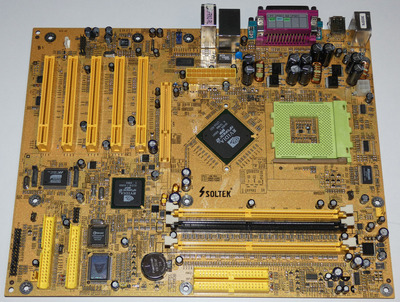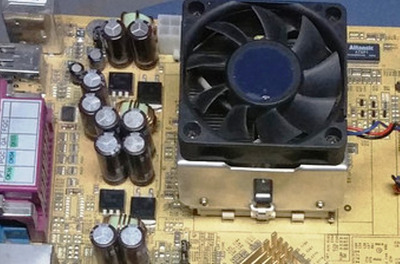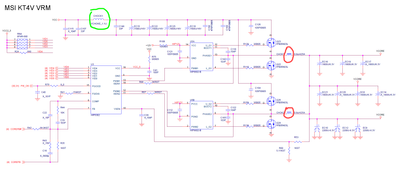Hi!
Have read this forum for some time, now registered. I'm also repairing an Soltek board (SL65DVB, Pentium III 1ghz) which I bought with caps very bulged. After buying it I was told that someone had already tried to change a few of them... The changed ones were six caps in VRM sections which were replaced with some very cheap looking ones. Solderwork was awful. I replaced them with panasonic fm's. Also changed other caps (many of them were also bulging) with salvaged but known to work low esr caps. The physically smallest ones I kept unchanged though, they all look good.
Also reflashed the bios as it had bios for different chipset. Learned a lot about eeprom chips as I didn't have a proper programmer, only 3com network card with address lines enough for 128kb chips. With linux split command, modding the software and adding switch to manually switch between the upper and lower 128k of 256k eeprom, I managed to successfully program it 😀
But back to the subject, the motherboard is still not working. Tried different cpu's and power supplies and whatever. Why I'm posting this to your thread is because it's behaving exactly as your board. No beeps etc. just fans spinning and cpu heating up. And today I started measuring the VRM section inspired by your post. I'm currently using my non-retro PC's PSU, 750W Evga Gold to have as accurate voltages as possible.
Theres three big mosfets on the board, two of them in VRM section. I measured voltages on those mosftes backplates against GND: 3.30V, 4,98V and 1.76V which I guess is Vcore.
In my board there's only one HIP ic, HIP6018BCB. I measured it and just like in your board VSEN is lower than Vcore, 1.40V. PGOOD is obviously low and FAULT pin which is used to indicate only overvoltage&overcurrent is low as it should be. What I can see through the legs of the component (for some pins traces are under the component) PGOOD and FAULT are also not connected to anywhere on to board... The voltages might be monitored by some other ic. If this behavior that VSEN is about 35mV lower than Vcore, so much that PGOOD goes down, is not some Solteks weird design by purpose, then I guess we have same problem with our mobos 😀
When I change the CPU to Celeron 500MHZ with recommended Vcore voltage around 2,00V, the Vcore also changes. VSEN stays at 1,60V. So the voltage identification system at least works. https://en.wikipedia.org/wiki/Voltage_regulat … _identification
Have you connected LED's to your mobo, what they show? For me after powering the board up:
-POWER LED lights up
-HDD led lights up, if a hdd with power cable is connected (i guess the led pin is just connected in pcb to the isa connector directly...)
-SUSPEND led blinks. Shouldn't a suspend led be off when your computer is running?! The suspend led is connected to a NE555 timer which generates the blink and it's not particulary fast or slow, just a regular suspend blink what you can see on various electronic devices. I haven't yet managed to find which component controls the NE555. But anyways I guess this blink is caused by the weird voltages in the HIP ic / VRM section. I don't fully understand yet how that voltage regulation and HIP ic works, but I guess the voltages are monitored by some other chip. And that chip puts the led blinking because voltages don't match.
I'll post more when I continue investigating the problem.
-eebenz
EDIT: I managed to find schematics for Soltek 65KV. Page 17 is the VRM and HIP chip. Cross on pins means they are not connected/used. Fault, pgood and rt have those crosses. In my mobo, the 555 timer circuit which blinks the suspend button is reseted by south bridge. Now it's not reseting it. I'll read that schematic more some other day, I'll go to sleep now. Heres a link to the schematic, I hope it's okay to post it here: https://www21.zippyshare.com/v/VAMqLvSl/file.html
